| Citation: | Yuan Ruo-xi, Wang Gui-ling, Liu Feng, Zhang Wei, Wang Wan-li, Cao Sheng-wei. 2021. Evaluation of shallow geothermal energy resources in the Beijing-Tianjin-Hebei Plain based on land use. Journal of Groundwater Science and Engineering, 9(2): 129-139. doi: 10.19637/j.cnki.2305-7068.2021.02.005 |
Evaluation of shallow geothermal energy resources in the Beijing-Tianjin-Hebei Plain based on land use
-
Abstract
To discover the characteristics, distribution and potential of shallow geothermal energy in the Beijing-Tianjin-Hebei Plain area. This paper, based on a large amount of data collection and field investigations, evaluateed the shallow-layer geothermal energy in the study area through the analytic hierarchy process and comprehensive index method. Based on suitability zoning results superimposed with 1:100000 land use data, the study area is divided into encouraged, controlled, restricted and prospective mining areas regarding the development of shallow geothermal energy, and the economic availability of shallow geothermal energy in the encouraged and controlled areas are evaluated. The results show that the shallow geothermal energy in the Beijing-Tianjin-Hebei Plain can meet the heating and cooling demand of 6×108 m2 of buildings, equivalent to 1.15×107 t of standard coal, thus reducing carbon dioxide emissions by 2.73×107 t and reducing sulfur dioxide emissions by 1.95×105 t. According to the development and utilization mode, the energy demand level and the Beijing-Tianjin-Hebei coordinated development plan, the development and utilization of geothermal resources in the plain area has two types: Urban concentrated mining areas and rural scattered mining areas. The scale and level of intensive utilization of regional geothermal resources are of great significance.
-

-
References
[1] China Geological Survey. Handbook of Hydrogeology(Second Edition). 2012. Beijing: Geological Publishing House. (in Chinese) [2] Francesco T, Sara K, Mohame E, et al. 2018. Suitability evaluation of specific shallow geothermal technologies using a GIS-Based multi criteria decision analysis implementing the analytic hierarchic process. Energies, 11(2): 457. doi: 10.3390/en11020457 [3] Guan Y, Wei YX, Chen XF, et al. 2014. Methodological study of suitability zoning of shallow geothermal development and utilization-with shallow geothermal energy investigation and assessment as example. Geology of Anhui, 24(1): 28-31. (in Chinese) [4] Lin WJ. 2012a. The study of thermal regulation and storage capacity in shallow geological environment and it’s availability. Chinese Academy of Geological Sciences. (in Chinese) [5] Lin WJ, Wu QH, Wang GL. 2012b. Shallow geothermal energy resource potential evaluation and environmental effect in China. Journal of Arid Land Resources and Environment, 26(3): 58-61. (in Chinese) [6] Long XT, Yuan RQ, Pi JG, et al. 2016. Survey and evaluation of shallow geothermal energy in Changsha. Journal of Natural Resources, 31(1): 163-176. (in Chinese) [7] Luo J, Joachim Rohn, Wei X, et al. 2016. A review of ground investigations for ground source heat pump (GSHP) systems. Energy and Buildings, 117: 160-175. doi: 10.1016/j.enbuild.2016.02.038 [8] Ma F, Wang XY, Wang GL, et al. 2015. Analysis of the potential and development prospects of shallow geothermal energy and hot dry rock resources. Science & Technology Review, 33(19): 49-53. [9] Saaty TL. 1990. How to make a decision: The analytic hierarchy process. European Journal of Operational Research, 48(1): 9-26. doi: 10.1287/inte.24.6.19 [10] Somogyi V, Sebestyen V, Nagy G. 2017. Scientific achievements and regulation of shallow geothermal systems in six European countries-A review. Renewable and Sustainable Energy Reviews, 68(2): 934-952. doi: 10.1016/j.rser.2016.02.014i [11] Standards of the Geological Mining Industry of the People's Republic of China. Specification for Shallow Geothermal Energy Investigation and Evaluation (DZ/T0225-2009). Beijing: Ministry of Land and Resources of the People’s Republic of China. (in Chinese) [12] Wang GL, Zhang W, Liang JY, et al. 2017a. Evaluation of Geothermal Resources Potential in China. Acta Geoscientica Sinica, 38(4): 449-459. (in Chinese) [13] Wang GL, Zhang W, Lin WJ, et al. 2017b. Research on formation mode and development potential of geothermal resources in Beijing-Tianjin-Hebei region. Geology in China, 44(6): 1074-1085. (in Chinese) [14] Wang GL. 2018. Atlas of shallow geothermal energy in major cities of China. Science Press. (in Chinese) [15] Wang GL, Liu YG, Zhu X, et al. 2020. The status and deveiopment of geothermal resources in China. Earth Science Frontiers, 27(1): 001-009. (in Chinese) [16] Wang WL, Wang GL, Zhu X, et al. 2017. Characteristics and potential of shallow geothermal resources in provincial capital cities of China. Geology in China, 44(6): 1062-1073. (in Chinese) [17] Wei WS, Zheng JS, Li WW, et al. 2010. Evaluation of shallow geothermal energy resources. China Cartographic Publishing House. (in Chinese) [18] Wu Y. 2014. The research on environmental problems and key technologies of shallow geothermal energy. China University of Geosiences. (in Chinese) [19] Xing H, Di YS, Yong Y. 2019. Analysis on the law of occurrence of shallow geothermal energy in Zhoukou City of Henan Province, China. Journal of Groundwater Science and Engineering, 7(3): 282-287. doi: 10.19637/j.cnki.2305-7068.2019.03.008 [20] Yuan RX, Liu F. 2020. The assessment of shallow geothermal resources in Beijing-Tianjin-Hebei region promotes the development of green energy in this Area. News Letters of China Geological Survey, 6(3): 17-21. (in Chinese) [21] Zhang ZJ, Fei YH. 2009. Atlas of groundwater sustainable utilization in north china plain. China Cartographic Publishing House. [22] Zhu X, Zhang QL, Wang WL, et al. 2015. Study on the influencing factors of rock-soil thermophysical parameters in shallow geothermal energy. Journal of Groundwater Science and Engineering, 3(3): 256-267. [23] Zhu X, Zhang QL, Wang GL, et al. 2018. Evaluation of shallow geothermal resources in Hebei Province. China Energy and Environmental Protection, 40(10): 127-131. (in Chinese) -
Access History

-
Figure 1.
Scope of the study area
-
Figure 2.
Flow chart of shallow geothermal resources evaluation in Beijing-Tianjin-Hebei Plain
-
Figure 3.
Suitability zoning of GWHP
-
Figure 4.
Suitability zoning of GCHP
-
Figure 5.
Land use pattern in Beijing-Tianjin-Hebei region (2018)
-
Figure 6.
Protection zoning of GWHP
-
Figure 7.
Protection zoning of GCHP
-
Figure 8.
Development and utilization zoning for shallow geothermal energy in Beijing-Tianjin-Hebei region





 DownLoad:
DownLoad:






